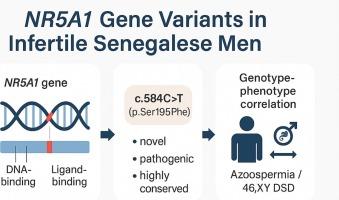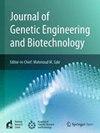塞内加尔不育男性NR5A1基因变异:一种新的错义变异和基因型-表型相关性的发现
IF 2.8
Q3 Biochemistry, Genetics and Molecular Biology
Journal of Genetic Engineering and Biotechnology
Pub Date : 2025-09-27
DOI:10.1016/j.jgeb.2025.100578
引用次数: 0
摘要
编码甾体生成因子1 (SF-1)的NR5A1基因在性别分化和精子发生中起着关键作用。然而,撒哈拉以南非洲人群中NR5A1变异的数据仍然有限。这项探索性初步研究旨在鉴定和表征塞内加尔不育男性的NR5A1变异,并评估基因型-表型相关性。我们对23名塞内加尔不育男性进行了横断面研究,并使用Sanger方法对NR5A1外显子2 -7进行了测序。检测到的变异使用计算机预测工具进行分析,并使用gnomAD数据库过滤罕见度(小等位基因频率<; 1%)。采用Fisher精确检验分析基因型-表型相关性。83%的患者至少携带一种NR5A1变异基因。一种新的杂合错义变异,c.584C > T (p.Ser195Phe),位于SF-1的铰链区域,在三个无亲缘关系的个体中被发现,表现为小阴茎、睾丸萎缩和无精子症。还检测到几个先前描述的变体。基因型-表型相关分析显示,NR5A1变异与最常见的临床特征生精失败(60.8%)之间存在显著关联。这些发现证明了塞内加尔男性不育症患者NR5A1基因的大量遗传变异,并确定了一种新的错义变异。我们的研究强调了NR5A1在男性不育筛查中的相关性,并强调了将非洲人群纳入生殖遗传学研究的重要性。本文章由计算机程序翻译,如有差异,请以英文原文为准。

NR5A1 gene variants in infertile Senegalese men: Discovery of a novel missense variant and genotype-phenotype correlation
The NR5A1 gene, encoding Steroidogenic Factor 1 (SF-1), plays a critical role in sex differentiation and spermatogenesis. However, data on NR5A1 variants in sub-Saharan African populations remain limited. This exploratory pilot study aimed to identify and characterize NR5A1 variants in infertile Senegalese men and to assess genotype–phenotype correlations. We conducted a cross-sectional study in 23 infertile Senegalese men, and exons 2 –7 of NR5A1 were sequenced using the Sanger method. Detected variants were analyzed with in silico prediction tools and filtered for rarity (minor allele frequency < 1 %) using the gnomAD database. Genotype–phenotype associations were analyzed using Fisher’s exact test.
Eighty-three percent of patients harbored at least one NR5A1 variant. A novel heterozygous missense variant, c.584C > T (p.Ser195Phe), located in the hinge region of SF-1, was identified in three unrelated individuals presenting with micropenis, testicular hypotrophy, and azoospermia. Several previously described variants were also detected. Genotype–phenotype correlation analysis revealed significant associations between NR5A1 variants and spermatogenic failure, the most common clinical feature (60.8 %). These findings demonstrate substantial genetic variability in NR5A1 among Senegalese men with infertility, and identify a novel missense variant. Our study highlights the relevance of NR5A1 in male infertility screening and emphasizes the importance of incorporating African populations into reproductive genetics research.
求助全文
通过发布文献求助,成功后即可免费获取论文全文。
去求助
来源期刊

Journal of Genetic Engineering and Biotechnology
Biochemistry, Genetics and Molecular Biology-Biotechnology
CiteScore
5.70
自引率
5.70%
发文量
159
审稿时长
16 weeks
期刊介绍:
Journal of genetic engineering and biotechnology is devoted to rapid publication of full-length research papers that leads to significant contribution in advancing knowledge in genetic engineering and biotechnology and provide novel perspectives in this research area. JGEB includes all major themes related to genetic engineering and recombinant DNA. The area of interest of JGEB includes but not restricted to: •Plant genetics •Animal genetics •Bacterial enzymes •Agricultural Biotechnology, •Biochemistry, •Biophysics, •Bioinformatics, •Environmental Biotechnology, •Industrial Biotechnology, •Microbial biotechnology, •Medical Biotechnology, •Bioenergy, Biosafety, •Biosecurity, •Bioethics, •GMOS, •Genomic, •Proteomic JGEB accepts
 求助内容:
求助内容: 应助结果提醒方式:
应助结果提醒方式:


